
I mean, why should your child bother learning braille, right? There are screen readers, audio books, and somebody can always read textbooks to your child at home. Maybe you’re thinking your child can just pick up information in class by listening really well, as you may have heard that studies have proven that people who are blind hear and retain better. The reason your child with a visual impairment should learn braille is the quality of life that this skill grants. Braille is necessary for basic literacy, an increase in knowledge, an overall higher marketability, and greater independence. Since literacy is the basic foundation of these benefits, let us start there.
What is Literacy?
A basic definition of literacy is the ability to read and write. The digital age allows much reading to be done by sound, given the easy access to audio books that we now have. This digital technology falls short in writing, however. There are speech-to-text software packages available that allow you to speak into a microphone and the computer converts the words into a document for the user, but there are limits to this. Transcription software is not always capable of understanding everyone, especially those who have thicker accents. From a writing perspective, it is simpler to write it out for yourself, so that there is no misunderstanding on the part of the computer. Of course, you need basic reading skills in order to edit your own writing.
Literacy Relies on Spelling
Proper spelling is essential to writing, but this is not as easy as it sounds. The English language is not as phonetic as you might think, meaning that words are not always spelled the way they sound. Take for instance the words “psychology” or “xylophone.” There is a silent “p” at the beginning of the former and the latter has an “x” that sounds like a “z”. Oddly enough, the “x” usually sounds that way unless it stands alone. As if that wasn’t hard enough to cope with, we have homophones (words that sound the same but have a different spelling) and homonyms (words with the same spelling but sound different). Oh, and don’t forget the homographs; those are words that are spelled the same, have the same sound, but come with multiple definitions. Examples of homophones are “sea”, as in a large body of water smaller than an ocean, and “see”, to receive information through the eyes. A homonym could be “read” and “read”; to read is the act of reading, but pronounced with the long “e” sound, while “read” is pronounced with a short “e” sound and is the past tense of read. A good homograph would be “cake”. As a noun, “cake” is a yummy dessert, but as a verb, it means to cover something liberally with something like mud. Many words in our language are like this; some words even fall into multiple categories.
Literacy Includes Punctuation
I will keep this short and sweet. Sighted folks often have trouble learning how to correctly use commas, colons, and semicolons; without a proper education in braille and the punctuation marks included in the code, people who can’t see won’t be able to get it either. Transcription software does not account for your pauses or any of the other reasons that we use punctuation. These marks are inserted by telling the software to put them in. This also requires a working knowledge of the rules of English.
What Are the Benefits of Reading Braille?
Literacy and language are the cornerstones to a productive life for everyone. The ability to access material quickly and consistently is also a benefit of reading braille. Many of the people we spoke with feel that reading braille allows them to better retain information from a book or website than by just listening to it. Another benefit of braille reading is the ability to make notes for yourself in class and for presentations. Many students today use a Perkins brailler or braille notetaker to write notes in class, as opposed to using a digital recorder to listen to them later, over and over. Mark Maurer, president of the National Federation for the Blind, carries note cards in braille with him as a way of keeping track of what he’s doing, where he’s going, and as a means of having a speech ready at any given time. Without note cards, he would have to either make the speeches up as he goes or memorize a couple of them. Neither of those options would really work for him.
Employment
Without vision, future employment opportunities are significantly limited. Being competitively employed means having skills that make you look good to an employer and will cause you to be chosen over someone else, despite any additional work that may be necessary to make the workplace more accessible. There are some blind auto mechanics, but they are braille literate in order to access the vehicle manuals. Most menial labor jobs require reading or at least visual recognition, and higher-level positions require a more in-depth education, which requires some form of literacy.
Independence
Braille literacy also means greater independence, along with the ability to be employed. Things like the microwave and the refrigerator can be labeled in braille, along with stuff you pick up from the grocery store. You can use a label reader to read the cans and then emboss them with braille for later. There are more tips on our independent living page, but this is just one example of how braille reading can lead to a more productive and independent lifestyle. There is certainly some hard work involved, but the ability to read and write, to make notes, and to reference materials without the need of a digital format makes life better. You can do your own homework, write and edit your own material and hold your own in the workplace. Braille enables you to read room numbers and select only the floor you want in an elevator. And braille’s best kept secret is reading with all the lights off.

This article was originally posted on the BrailleSC website, which was funded by a grant from the US Department of Education with support from the University of South Carolina Upstate and The Maryland Institute for Technology in the Humanities.




